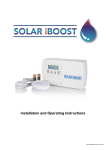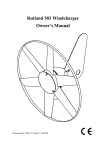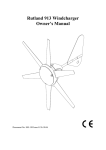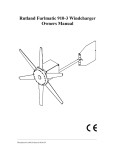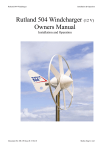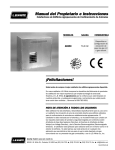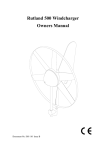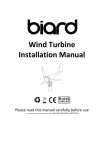Download Rutland FM1803-2 Furlmatic Windcharger Owners Manual
Transcript
Rutland FM1803-2 Furlmatic Windcharger Owners Manual Document No: SM-146 Issue D 14.03.08 Rutland FM1803-2 Document No: SM-146 Issue D 14.03.08 Installation & Operation 1 Marlec Engineering Co Ltd Rutland FM1803-2 Installation & Operation CONTENTS Page INTRODUCTION................................................................................ 3 CHECK YOU HAVE RECEIVED....................................................... 4 WHAT YOU WILL NEED, TOOLS, OTHER..................................... 4 SITING THE WINDCHARGER.......................................................... 5 SYSTEM DESCRIPTION & PRINCIPLE OF OPERATION………. 6 Aerofoil Blades Generator Tail Assembly Control Unit MOUNTING TOWER ………….……………………………………. 10 ASSEMBLY & INSTALLATION........................................................ 12 Blade & Hub Assembly.......................................... 12 Tail Assembly……………………………………. 14 Tower Preparation..............................……………. 15 Control Unit Installation………………………….. 16 BATTERIES.....................................................................................… 17 CABLE SPECIFICATION................................................................... 18 ELECTRICAL CONNECTION........................................................... 19 FITTING GENERATOR TO THE TOWER………………………… 20 Final Mechanical check…………………………. 20 UP AND RUNNING........................................................................... 21 SPECIFICATION AND PERFORMANCE......................................... 22 INSPECTION AND MAINTENANCE............................................... 23 TROUBLESHOOTING....................................................................... 24 Document No: SM-146 Issue D 14.03.08 2 Marlec Engineering Co Ltd Rutland FM1803-2 Installation & Operation INTRODUCTION This manual contains important information concerning your Rutland FM1803 Series 2 Windcharger system and its installation and operational characteristics. It is strongly recommended that you read this manual and familiarise yourself with its contents before installing and operating the Windcharger system. The Rutland FM1803 Series 2 Windcharger is designed to provide a direct current (DC) power supply via a battery bank for low voltage equipment, lighting, inverters etc. in domestic and professional applications. WARNING! • When turning, the Windcharger is capable of generating voltages in excess of the nominal voltage Caution must be exercised at all times to avoid electric shock. • Never disconnect the batteries from the controller when the turbine is running. • The wind generator must never be operated on open circuit, (ie without control unit connected, since hazardous voltages can be generated. • No attempt to work on the system should be made until the wind generator is restrained from turning. • The Windcharger is fitted with ceramic magnets which can be damaged by heavy handling. The main generator assembly should be treated with care during transit and assembly. • It is essential to observe the correct polarity when connecting the Windcharger and all other components into an electrical circuit. Reverse connection will damage the Windcharger system and invalidate the warranty. . • Do not adjust the settings on the control unit without reference to the manufacturer. • If in doubt, refer to your dealer, a competent electrical engineer or the manufacturer. Document No: SM-146 Issue D 14.03.08 3 Marlec Engineering Co Ltd Rutland FM1803-2 Installation & Operation CHECK YOU HAVE RECEIVED • • • • • Three (3) Aerofoil Blades and 9 nuts and bolts Main Generator Assembly Tail Fin assembly and Fixings Spinner and fixing screws Control Unit – Check that the voltage indicated on the connection label and the side of the housing corresponds with your battery voltage. • 3 Way Connector Block In the event of loss or damage, consult your dealer or the manufacturer. WHAT YOU WILL NEED Tools • • • • • • • • • Suitable wire stripper Small terminal screwdriver Phillips (cross-head) screwdriver 2 x 13mm spanners or sockets 10mm spanner or socket 8mm Allen key 6mm Allen key 4mm Allen key Flat blade screwdriver Other Items You Will Need • • • • • • • Mounting tower Winch or other suitable lifting/pulling equipment Cable Batteries Battery terminals Connector blocks (as determined by your total system) Suitable fixings for wall mounting control unit. Please complete the system details in the maintenance schedule (appendix A). This information is important & should be kept safe & available if contacting the manufacturer for advice or technical information. Document No: SM-146 Issue D 14.03.08 4 Marlec Engineering Co Ltd Rutland FM1803-2 Installation & Operation SITING THE WINDCHARGER The location and height of the mounting pole or tower for your wind turbine will be the major factor in the overall performance of your system. The smooth flow of wind over land and water is often interrupted by a multitude of obstructions causing wind sheer and turbulence. Wind sheer describes the interference between the fast moving upper air and the slow moving air close to the ground and the resulting decrease in average wind speed as one gets closer to the ground. Turbulence is caused by the wind passing over obstructions such as trees and buildings. Both wind sheer and turbulence diminish with height and can be overcome simply by putting the machine sufficiently high above them. It is therefore essential that the wind generator should be located in an area as free as possible from disturbed wind flow. Bear in mind that downwind obstructions can be as detrimental to performance as upwind obstructions (Fig.1). AREA OF TURBULENCE Fig.1 WIND DIRECTION 2H H 2H Document No: SM-146 Issue D 14.03.08 20H 5 Marlec Engineering Co Ltd Rutland FM1803-2 Installation & Operation SYSTEM DESCRIPTION & PRINCIPLE OF OPERATION Aerofoil Blades & Rotor The 1803 rotor consists of 3 aerofoil blades rigidly fixed to a hub. The blades are at an optimum fixed pitch for variable speed operation over a wide wind speed range. Generator The rotor is rigidly attached to the generator shaft providing direct drive to the 3 phase brushless permanent magnet ac generator, producing variable frequency ac at approx 120v L-L under normal conditions. Note: the generator must not be allowed to run open circuit since high voltages can be generated. Yaw system The complete wind generator assembly is mounted on yaw bearings allowing free rotation on it’s vertical axis to enable it to respond to changes in wind direction. The yaw assembly also includes a slipring & brush system to transmit the generated current to the fixed transmission cable while allowing free 360° yaw rotation. Tail assembly The inclined tail fin is hinged to the rigid tail boom on durable sleeve bearings. The tail is designed to direct the turbine into the main direction of wind at wind speeds up to approx 35mph, above this the automatic ‘furling’ mechanism will turn the generator at an angle to the wind to protect the generator, turbine & supporting structure from severe winds. During furling the output power will be reduced. When the high wind subsides, the tail assembly will automatically return the turbine to normal operation. In turbulent conditions the system may be seen to repeat this cycle many times. Document No: SM-146 Issue D 14.03.08 6 Marlec Engineering Co Ltd Rutland FM1803-2 Installation & Operation Control Unit The 1803 MPC1 control unit controls the operation of the FM1803-2 wind generator & protects the battery bank from overcharge. The 3 phase transformer & full wave bridge rectifier convert the raw generated 3 phase ac to dc at a level corresponding to the battery voltage. The microcontroller based electronic controller monitors the battery voltage, charge current & temperature. At pre-set levels, the controller will switch the generator between Low and High wind modes to ensure optimum performance. When the battery voltage reaches a level indicating fully charged, the controller switches the generator to ‘stalled’ mode causing the generator RPM to reduce to a slow idle, preventing further power being generated into the battery bank. When the battery voltage falls to a lower pre-set limit, the control unit will automatically switch back to ‘charge’ mode. Unless otherwise specified at the time of order, the limits will be set for lead acid batteries (upper limit 2.4v/cell & lower limit 2.08v/cell @ 25°C). If other types of battery are to be used or other settings are required, contact the manufacturer for advice. When in ‘stalled’ mode, the system can be manually re-set to ‘charge’ mode by pressing the reset button on the front panel. Temperature compensation ensures that the battery voltage switching points are automatically adjusted for ambient temperature to maintain optimum battery performance. A digital LCD display shows battery voltage, charge current, generated power, operating mode & warnings. Coloured LEDs also indicate operating status & warnings. The on/off switch on the front panel allows the control unit to be switched off which will select ‘stalled’ mode for installation / servicing, stalling the turbine to a slow idle & preventing power being produced. In this mode the LCD display will be blank. If a battery is not connected, the control unit will default to stall mode. There are 3 continuous operating modes: Mode Low/High LED Charge Low Wind Green Charge High Wind Red Stalled Red Document No: SM-146 Issue D 14.03.08 Charge/Stall LED Green Green Red 7 LCD Display Charge Low Wind Charge High Wind Turbine Stalled Marlec Engineering Co Ltd Rutland FM1803-2 Installation & Operation Transitional modes indicated by LEDs: Charge/Stall LED Flashing Green/Amber – Currently in charge mode, the battery voltage has reached the fully charged level & a time delay period has started prior to entering stall mode, the voltage must remain at this level for the whole of the time period before a mode change will take place. If the voltage falls again while in this phase, the LED will stop flashing & the controller will stay in charge mode. This is to prevent unnecessary change of mode during transient voltage changes. Charge/Stall LED Red/ pulsing off once per second – The Controller has switched to stall mode & a time delay period has started to allow the turbine to stabilize in the new operating mode before re-checking the battery voltage. Charge/Stall LED Flashing Red/Amber – Currently in stalled mode, the battery voltage has reached the lower voltage limit & a time delay period has started prior to entering charge mode, the voltage must remain at this level for the whole of the time period before a mode change will take place. If the voltage rises again while in this phase, the LED will stop flashing & the controller will stay in stall mode. This is to prevent unnecessary change of mode during transient voltage changes. Charge/Stall LED Green/ pulsing off once per second – The Controller has switched to charge mode & a time delay period has started to allow the turbine to stabilize in the new operating mode before re-checking the battery voltage. Low/High Wind LED Flashing Green/Amber – Currently in Low wind mode, the charge current has reached the upper limit for low wind mode & a time delay period has started prior to entering High wind mode, the current must remain at this level for the whole of the time period before a mode change will take place. If the current falls again while in this phase, the LED will stop flashing & the controller will stay in Low wind mode. This is to prevent unnecessary change of mode during transient current changes. Low/High Wind LED Red/ pulsing off once per second – The Controller has switched to High wind mode & has started a time delay period to allow the turbine to stabilize in the new operating mode before re-checking the charge current. Low/High Wind LED Flashing Red/Amber – Currently in High wind mode, the charge current has reached the lower limit for high wind mode & a time delay period has started prior to entering Low wind mode, the current must remain at this level for the whole of the time period before a mode change will take place. If the current increases again while in this phase, the LED will stop flashing & the controller will stay in High wind mode. This is to prevent unnecessary change of mode during transient current changes. Document No: SM-146 Issue D 14.03.08 8 Marlec Engineering Co Ltd Rutland FM1803-2 Installation & Operation Low/High Wind LED Green/ pulsing off once per second – The Controller has switched to Low wind mode & has started a time delay period to allow the turbine to stabilize in the new operating mode before re-checking the charge current. Note: High/Low wind mode switching is inactive when the controller is in Stall mode. In Stall mode, high wind mode will also be selected to prevent high transient currents if the controller switches back to charge mode during high winds. Warnings Mode Low Battery Volts Over Temperature Low/High LED Flashing Red Flashing Red Charge/Stall LED LCD Display Flashing Red Warning: Low Bat Flashing Red Over Temperature Both Leds flashing alternately Red & LCD display ‘Warning: Low Bat’ – Battery voltage is below the minimum recommended level & is therefore seriously discharged, any loads should be removed & the batteries recharged as soon as possible to avoid permanent damage to the battery. Both Leds flashing alternately Red & LCD display ‘Over Temperature’ – The internal components of the control unit have reached a higher than normal temperature. The turbine will be stalled and the cooling fan will run until the temperature has reduced to normal levels when the turbine will resume normal operation. If this occurs, check that the controller housing vents are not obstructed. The control unit has a built in cooling fan which will only operate when the internal temperature of the control unit exceeds a pre-set level. This will only normally operate during periods of high generated power levels. Document No: SM-146 Issue D 14.03.08 9 Marlec Engineering Co Ltd Rutland FM1803-2 Installation & Operation MOUNTING TOWER The Rutland 1803-2 is designed to fit inside a round tube with an internal diameter of 81mm. A suitable mounting pole can be erected using 80mm (3“) galvanised (medium) tube to BS1387 a minimum height of 6.5m, 10m or greater is recommended. The tube must be supported by a minimum of 2 sets of four guy lines. The attachment points for the guy lines to the tower should be securely fixed to the tower. • All items should be galvanised or stainless steel for protection against corrosion. • Where guy lines are looped, the loop must incorporate a thimble and be fitted with a minimum of three rope grips. • All ground fixings must be made suitable according to the ground conditions. Pivot type towers are recommended as these allow for easier installation and lowering for access to the wind generator for maintenance. A form of pivoting tower is suggested in Fig 2. Non-guyed pivoting towers are available, for further tower details contact the dealer or manufacturer. Document No: SM-146 Issue D 14.03.08 10 Marlec Engineering Co Ltd Rutland FM1803-2 Installation & Operation R4400 1300 2600 2600 Fig 2. Typical Tower Document No: SM-146 Issue D 14.03.08 11 Marlec Engineering Co Ltd Rutland FM1803-2 Installation & Operation ASSEMBLY AND INSTALLATION OF THE WINDCHARGER Blade & Hub Assembly The blade hub rear assy complete with blade bolts is pre-fitted to the generator shaft, this must not be removed to fit the turbine blades. Turbine Blade Flat Side of Blade M8 washers Hub Rear Assy with protruding blade bolts M8 Nylock Nuts Hub Front Plate ‘D’ washer Tab washer Spinner fixing boss M10 x 25 Fig 3. Blade Hub Assembly Document No: SM-146 Issue D 14.03.08 12 Marlec Engineering Co Ltd Rutland FM1803-2 Installation & Operation Blade & Hub Assembly continued Fit the 3 turbine blades to the protruding blade bolts, ensuring the flat surface of the blades faces the front plate. Fit the front hub plate to the shaft with the pre-fitted pins protruding outwards. Ensure alignment with the flats on the shaft, the pins with the holes in the hub boss, and the cutouts with the spinner fixing holes in the blades. Fit the nuts & washers to the blade bolts & tighten using 2 x 13mm spanners. If necessary use a flat blade screwdriver from the back of the hub assembly to push the bolts through. Using a suitable hammer, drive the 3 protruding pins into the corresponding holes in the front plate & boss assy, until the pins are flush with the front plate. Fit the centre screw, ‘D’ washer & tab washer to the assembly & tighten the screw securely to push the assembly back against the shoulder on the shaft. Ensure there is no gap between the rear hub plate & shaft shoulder. Using a hammer & suitable drift, bend the edges of the tab washer against the flats on the centre screw to prevent loosening. Check tightness of all screws. (Do not over-tighten). Fit the plastic spinner in position on the front of the generator hub and secure in place with the 3 No10 x 9.5 screws provided. Alternatively the turbine and spinner can be fitted after mounting the generator assembly to the tower. Insert tab washer into slot in front hub plate Bend a corner of the tab washer against a flat on the bolt head Fig 4. Turbine Assembly Fixing Document No: SM-146 Issue D 14.03.08 13 Marlec Engineering Co Ltd Rutland FM1803-2 Installation & Operation Tail Assembly Insert the tail assembly into the end of the tail boom, aligning the threaded holes in the tail mounting with the clearance holes in the tail boom. Insert the two M10 x 16 Button Cap Screws & Shakeproof washers & tighten to a torque of 20Nm. When fitted, the tail fin will be inclined 15° to the vertical. Tail Assembly M10 Button Cap Screws & Shakeproof washers Tail Boom Fig 5. Tail Assembly Document No: SM-146 Issue D 14.03.08 14 Marlec Engineering Co Ltd Rutland FM1803-2 Installation & Operation Tower Preparation • The post adaptor fitted to the 1803-2 is designed to fit inside a standard 81mm (3”) internal diameter tube. The adaptor is provided with a flat on one side to clear the weld seam on seamed pipe. • Mark and centre-punch four positions diametrically opposite, at 45° to the pipe seam if necessary, 20mm from the top of the tube. • Drill four holes 12.5mm in diameter on centre-punch positions & remove burrs. Post Adaptor M12 x 25 Button Cap Screws & Shakeproof Washers 20 Top of Tower Pipe Seam Fig 6. Tower Preparation Document No: SM-146 Issue D 14.03.08 15 Marlec Engineering Co Ltd Rutland FM1803-2 Installation & Operation Control Unit Installation The Control unit should be installed as close as possible to the batteries to minimise the length of the main battery leads, at the same time the unit should be protected from battery fumes from vented batteries. Ensure adequate ventilation is provided to allow efficient heat dissipation via the control unit vents. These vents must not be covered or obstructed. The unit is not weatherproof & therefore must be suitably protected. Mount the unit securely to a wall or other vertical surface, using the mounting holes provided (hole centres are 270mm W x 200mm H), in a suitable location allowing for cable entries in the base of the unit. The cable entries are fitted with blanking grommets which need to be pierced or can be removed for attachment of 20mm conduit fittings if required. Vents Front Panel fixing screws On / Off Switch Mounting Holes LED Indicators Vents Mounting Holes Manual Re-set Push button Front Panel fixing screws Fig 7. Control Unit Document No: SM-146 Issue D 14.03.08 16 Marlec Engineering Co Ltd Rutland FM1803-2 Installation & Operation BATTERIES Total = 12v 400Ah 4800Wh Fig.8 Fig.9 Total = 24v 200Ah 4800Wh 12v 200Ah 12v 200Ah 12v 200Ah 12v 200Ah Leisure/Deep Cycle batteries are specifically designed for good performance in terms of charge/discharge cycles. Batteries are the most important part of your battery charging system and should be sized according to your load requirements and provide at least 3 days reserve capacity. This will reduce cycling, prolong the life of the battery and ensure system reliability during periods of low wind. If in doubt about battery sizing, contact your dealer or the manufacturer. The minimum battery capacity recommended is 400Ah @ 12v, 200Ah @ 24v Permanent connections should always be made to the battery terminals. Never use crocodile clips or similar devices. Battery terminals should be well greased with petroleum jelly or similar. Batteries may be linked as follows: • In parallel to increase amp hours (Fig.8). • In series to increase voltage (Fig.9). • A combination of series & parallel to achieve desired voltage & capacity. Only batteries of similar type & capacity & ideally the same manufacturer should be connected together in series or parallel. Ensure the voltage indicated on your controller corresponds with your battery voltage. Document No: SM-146 Issue D 14.03.08 17 Marlec Engineering Co Ltd Rutland FM1803-2 Installation & Operation CABLE SPECIFICATION The cable size used for connection of the Windcharger to the control unit should be in accordance with table 1 in order to minimise voltage drop and ensure optimum performance. 3 cores will be required. Cable Run (m) Up to 50 Up to 100 Up to 150 Up to 250 Up to 450 Up to 700 Up to 1000 Minimum Cable Size (mm²) AWG 1.5 16 2.5 14 4 12 6 10 10 8 16 6 25 4 Table.1 The cable size for connection of the control unit to the batteries should be 10mm² minimum; the use of smaller cables than recommended will reduce the performance of the charging system. The type of cable is dependent on the type of installation & national or local wiring regulations. All cables must be suitably protected from mechanical damage. All cables & installation should be in accordance with IEE Wiring regulations The 3 phase cable from the WG is coloured in accordance with amendment 2 to BS7671: 2001 (IEE wiring Regulations 16th Edition). Phase 1- Brown Phase 2 - Black Phase 3 - Grey Document No: SM-146 Issue D 14.03.08 18 Marlec Engineering Co Ltd Rutland FM1803-2 Installation & Operation ELECTRICAL CONNECTION • Remove the four screws from the control unit front panel, carefully remove the front panel by sliding upwards to release the latches into the main housing, withdraw until the ribbon cable connecting the front panel to the main housing can be accessed. Unplug the ribbon cable from the PCB in the main housing & the front panel can then be removed. • Using the cable selected (see Table 1), pass the cable through the inside of the tower & route to the control unit. Leaving sufficient length of cable protruding from the top of the tower to enable easy connection to the wind generator. • Pass the cables through the grommet or conduit in the base of the control unit & connect to the 3 terminals labelled for the wind generator. (The generator output is 3 phase ac, therefore these connections can be made in any sequence). • Using the cable selected for connection of the control unit to the batteries. Pass the cables through the grommet or conduit in the base of the control unit & connect to the 2 terminals labelled for the battery. It is vital to observe correct polarity when connecting the battery cables otherwise serious damage will result. • Re-connect the ribbon cable & re-fit the control unit front panel. Move the ON-OFF switch to the ‘OFF’ position. Battery Connections Wind Generator Connections Voltage Identification label Fig 10. 12 & 24v Control Unit Connections Document No: SM-146 Issue D 14.03.08 19 Marlec Engineering Co Ltd Rutland FM1803-2 Installation & Operation FITTING THE GENERATOR TO THE TOWER • Connect the wind generator flying leads to the cable protruding from the tower using the connector block supplied or other suitable connector. (The generator output is 3 phase ac, therefore these connections can be made in any sequence). Wrap the connection with insulation tape to secure/protect from the environment. It is recommended that cable restraint is fitted to prevent the weight of cable applying excessive load to the connections, a simple method of achieving this is shown in Fig 11. Cable From WG Cable Tie Connector Block Cable to Controller Fig 11. Cable strain relief • Carefully locate the wind generator post adaptor into the top of the tower ensuring the flat on the post adaptor aligns with the pipe seam if necessary. • Push the adaptor into the tower while the cable is gently pulled from the tower base to ensure it is not trapped, continue until the post adaptor is fully inserted into the tower and the fixing holes align. • Secure the wind generator to the tower using the four M12 x 25mm screws and shakeproof washers provided. Tighten using an 8mm Allen key. Final Mechanical Check • Check the tightness of the blade screws and nose dome. • Check the free rotation of the hub and yaw axis. • Check for free movement of the tail fin. Document No: SM-146 Issue D 14.03.08 20 Marlec Engineering Co Ltd Rutland FM1803-2 Installation & Operation UP AND RUNNING • Before raising and securing the wind generator, check that: 1. All final mechanical checks have been made. 2. The cable is not trapped. 3. All electrical connections are secure and safe. 4. The switch on the control unit is in the “OFF” position. • The wind generator can now be raised into position. Take care to avoid all moving parts when raising and lowering the wind generator. • When raised, secure the structure firmly in an upright position. The performance of your Windcharger can be impaired if the pole is not vertical. • Connect the battery cables to the battery terminals using suitable permanent connections. It is vital to observe correct polarity when connecting the batteries otherwise serious damage will result. • Move the switch on the control unit to the “on” position. If there is sufficient wind the turbine should now accelerate and the LCD should display the current operating conditions. Document No: SM-146 Issue D 14.03.08 21 Marlec Engineering Co Ltd Rutland FM1803-2 Installation & Operation SPECIFICATION AND PERFORMANCE The curve shown below is for ideal, non-turbulent wind conditions; this may not be achieved in some installations. 70 35 60 30 50 25 40 20 30 15 20 10 10 5 0 CHARGE CURRENT INTO 24V BATTERY (AMPS) CHARGE CURRENT INTO 12V BATTERY (AMPS) CHARGE CURRENT v WINDSPEED 0 0 5 10 15 20 25 30 35 40 WINDSPEED (M/S) Outline Dimensions (mm) Tower Top Weight: Controller Weight: Shipping Dimensions: 1 pallet: 1200x675x520mm 35.32Kg 9.94Kg Document No: SM-146 Issue D 14.03.08 22 74Kg Marlec Engineering Co Ltd Rutland FM1803-2 Installation & Operation INSPECTION AND MAINTENANCE To ensure long trouble free service from your 1803-2 wind generator, it is important to determine a suitable inspection & maintenance schedule. Maintenance intervals and requirements are specific to individual installations & site conditions & therefore must be determined by the user during the first year of service. It is recommended that during the first year following installation that inspections & necessary maintenance are carried out at 3, 6 & 12 months, the results of which are used to determine future scheduled maintenance. A maintenance schedule sheet is provided for convenience. It is recommended that the maintenance schedule is completed & kept safe, & available if contacting the manufacturer for advice or technical information. From the findings of the 3, 6 & 12 months inspections, the user should determine a suitable service interval. • Before inspection, the turbine should either be lowered to the ground or secured to prevent the generator from turning. To stop the generator from turning proceed as follows: Note: For safety reasons maintenance should not be attempted during strong winds. • Move the switch on the control unit to the “OFF” position. The turbine rpm should reduce to a slow idle. • Whilst the generator is in “stall” mode, it can be lowered to the ground or blades restrained from turning. Document No: SM-146 Issue D 14.03.08 23 Marlec Engineering Co Ltd Rutland FM1803-2 Installation & Operation TROUBLESHOOTING In the unlikely event that your Rutland 1803-2 should develop a defect, the turbine should either be lowered to the ground or secured to prevent the blades from turning before the following inspection is carried out. 1. Read the ‘Electrical Connection’ and ‘Up and Running’ sections and be satisfied that your system complies. 2. If your Rutland 1803-2 fails to turn, turns slowly or produces low output, check the following: • Is there sufficient wind? The Rutland 1803-2 needs 3m/s wind speed to start charging. The wind speed across the turbine blades may be greatly reduced in a built-up area compared with weather reports. • Is the On/Off switch in the ‘ON’ position? • Is the battery fully charged? Check the control unit LEDs, when the red LED is lit it indicates that the battery is fully charged & the wind generator will be in “stall” mode. • Is a battery connected to the control unit? Check the control unit LEDs, if no LED is lit this indicates no battery connection to the control unit & wind generator will be in “stall” mode. • Is the battery in good condition? Check the voltage and electrolyte level of each battery. • Check electrical continuity throughout the system, especially look for corrosion and poor connections in cable joints and connector blocks. • Check the brushes and slipring for wear or damage. To inspect the brushes, remove the nacelle by removing the three fixing screws and slide nacelle backwards towards the tail fin. The brushes and slipring can be inspected. Remove any black deposits from slipring with emery paper. • Check hub for free rotation with generator disconnected from control unit. If the hub does not rotate freely, check for a possible short circuit in the wiring. If no wiring fault is found refer to your dealer or manufacturer. If in doubt, refer to your dealer or manufacturer. Document No: SM-146 Issue D 14.03.08 24 Marlec Engineering Co Ltd Rutland FM1803-2 Installation & Operation FM1803-2 Maintenance Schedule (1st 12 months) System Details System Voltage Generator Serial Number Control Unit Serial Number Remarks Battery Capacity Battery Type Tower Height Date of Installation Check Service Interval Date 3 months Remarks Date Blade Bolts All other nuts & bolts Turbine for smooth free rotation Yaw axis for smooth free rotation Tail hinge for smooth free rotation General Condition Tower assembly condition Guy wire tension (if applicable) Document No: SM-146 Issue D 14.03.08 Marlec 25 Engineering Co Ltd 6 months Remarks Date 12 months Remarks Rutland FM1803-2 Installation & Operation FM1803-2 Maintenance Schedule System Details System Voltage Generator Serial Number Control Unit Serial Number Remarks Battery Capacity Battery Type Tower Height Date of Installation Check Service Interval Date Remarks Date Blade Bolts All other nuts & bolts Turbine for smooth free rotation Yaw axis for smooth free rotation Tail hinge for smooth free rotation General Condition Tower assembly condition Guy wire tension (if applicable) Document No: SM-146 Issue D 14.03.08 Marlec 26 Engineering Co Ltd Remarks Date Remarks Rutland FM1803-2 Installation & Operation LIMITED WARRANTY The Marlec Engineering Company Limited Warranty provides free replacement cover for all defects in parts and workmanship for 12 months from the date of purchase. Marlec's obligation in this respect is limited to replacing parts which have been promptly reported to the seller as having been in his opinion defective and are so found by Marlec upon inspection. Defective parts must be returned by prepaid post to Marlec Engineering Company Limited, Rutland House, Trevithick Road, Corby, Northamptonshire, NN17 5XY, England, or to an authorised Marlec agent. This Warranty is void in the event of improper installation, owner neglect or natural disasters and does not extend to support posts, inverters or batteries. No responsibility is assumed for incidental or consequential damage, damage caused by the use of any unauthorised components. No responsibility is assumed for non "furling" versions of the Rutland Windcharger (ie. the Standard and Marine generators) where Marlec or one of its authorised agents finds that a generator incorporating a furling device should have been used. Document No: SM-146 Issue D 14.03.08 27 Marlec Engineering Co Ltd































